|
|
|
Connecting
April 26, 2023
Click here for sound of the Teletype
| |
|
Colleagues,
Good Wednesday morning on this April 26, 2023,
Newsman or Newswoman or Newsperson or Reporter or Journalist? What’s your preference?
Our colleague Jim Carrier wrote to say: “I’ve always called myself a Newsman. But lately, perhaps because of the Woke Movement, my wife has suggested calling myself a Journalist. I’ve always thought that a tad effete. Now that I’m out of the newsroom, working on books, etc., I do like Writer. Jules Loh told me years ago that he wanted “Reporter” on his tombstone.
"What say the rest of you?"
(Despite numerous journalism awards in a 39-year career ending with his retirement, Loh, one of AP's most famous reporters, said of himself, “I am a reporter, period. They can chisel that on my gravestone.”)
Connecting put the question to our colleague John Daniszewski, AP vice president for Standards and Editor at Large and one of the most thoughtful people I know, and his reply: “We have moved away from gendered job titles, but newsperson is still used. I think it comes to personal preference often. In our system many employees are listed as newspersons, but we often call them just reporters or journalists. Some photographers prefer to be called that, but others like photojournalist, with the idea that they do more than snap, they tell stories.”
I hope to hear from you on your preference - and why.
In today’s issue we bring you a profile of colleague Russ Kaurloto, who left the AP when West communications executive director in Los Angeles for a career in the worlds of medicine, government and academe. He is now Vice Chancellor and Chief Information Officer at the University of Denver. It’s a great story of how someone a year out of high school joined the AP, advanced through the ranks to head the technical operations of one of AP’s largest bureaus, and with a degree has made his mark.
Have a great day – be safe, stay healthy, live each day to the fullest!
Paul
Thank you, Kia Breaux, for a story that needed to be told
Andy Lippman - How sad that Kia Breaux has to lend her writing talents to describing her odyssey of fear while living in her community. (See Tuesday’s Connecting)
I know the effects that being subjected to antisemitic slurs can bring, but as she clearly showed "you can't peel off your black skin." My encounters with those who had trouble with my religion were direct, but I wasn't subjected to someone who had trouble with me "driving while Jewish." Perhaps, dating while Jewish, or being a chief of bureau while Jewish occurred, but not enough to keep me in fear of my family's safety.
What a powerful and personal commentary on what is going on in this country. I teach citizenship at a literacy center in a predominantly Latino community of Los Angeles, and have heard these kind of stories over the years. I have heard of parents of my students picked up while sitting in their front yards and then deported. Why did ICE stop in the first place - because they saw a Latino sitting on a front porch.
And why did the police pull a man taking his daughter to middle school out of his car and arrest him. Because they were looking for undocumented people.
People like my students, and Kia, have reason to stay up late and cry and worry.
I'm glad that Kia's talent showed why all of us should stay up a night or two and worry about why this is happening.
Bravo Kia, but I'm sad that as your friend, you bear this burden. Hopefully, by your story, you may have someone else to empathize with and are enlightened by what's going on in their neighborhoods.
Celebrating Denny Vohar and a life well-lived
|  | |
From left: Gerry Petraitis, Larry Gold, Jim Limbach, Adrian Fullwood, Jerry Bodlander, Carrie Schumaker, Hugo Blanco, Ross Simpson (seated), Mike Gracia, Lisa Dwyer Shapiro, Jim Hood, and Jennifer Garske.
Jim Hood - In his 38 years with the AP, Denny Vohar’s travels with AP Radio crews spanned much of the globe -- to space launches, the White House and Olympic Games in Norway, Italy, Greece, China and elsewhere. His career also spanned several generations of AP employees, leaving many of us at his funeral Monday unfamiliar to each other.
We gathered briefly for a photo following the services in West Virginia, only later realizing we didn’t have everyone’s name. This shocking lapse was likened to Denny arriving at an Olympics venue without a microphone cable.
Severely downsized in recent years, AP Broadcast is a shadow of its former self. Even when at full strength, AP Radio was a tiny operation that – thanks to Denny and his colleagues – regularly matched and often beat much larger competitors. That team spirit lives on, as shown by the turnout for Denny’s services. We might all still be standing around talking had the funeral director not ushered us out.
Here’s a bit of Harry Belafonte trivia no one else has…
| 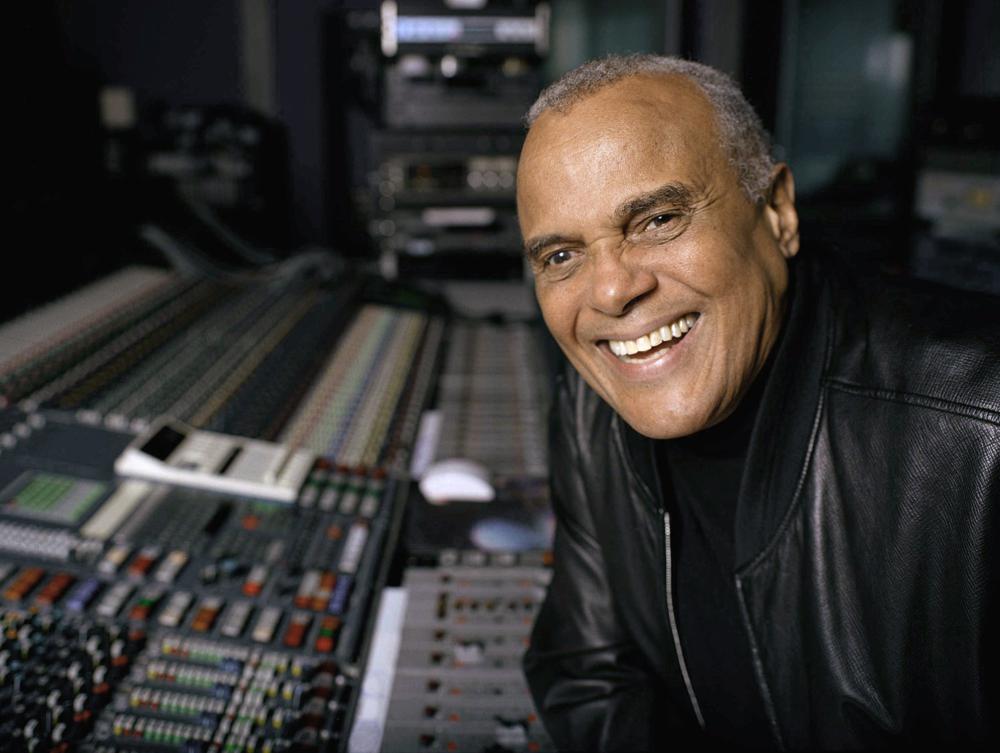 | |
FILE - Actor and singer Harry Belafonte poses for a portrait at a New York recording studio, Nov. 1, 2001. Belafonte died Tuesday of congestive heart failure at his New York home. He was 96. (AP Photo/Leslie Hassler, File)
Michael Weinfeld - All the Harry Belafonte tributes (he died Tuesday at 96) I saw on TV included the typical ingredients: his singing, his acting, his civil rights activities and his honors. But none had his connection to “Star Trek’s” Mr. Spock.
In a 2008 interview for AP Radio at the BNC in Washington, Leonard Nimoy told me that while he was developing his legendary Vulcan character, he took time out to see Belafonte in concert at the Greek Theatre in Los Angeles.
Nimoy watched as Belafonte “made an entrance that was very dramatic.” He described Belafonte as being “lit by a hot white spotlight standing dead still center stage as he sang without moving a muscle.” Nimoy recalled that Belafonte “had his hands on his thighs” and “created a quietude around himself with that posture.” Eventually,” Nimoy continued, “after some long period of time that seemed forever, he very slowly raised one arm out to the side as he sang.”
Nimoy described the move as “gigantic because it came from such a stillness.”
Nimoy saw how Belafonte’s “economy of movement” made that “one small move very, very powerful.”
The revelation helped Nimoy develop the personality of Mr. Spock. Nimoy said, “I learned that from a very quiet place, a quiet face, a raised eyebrow could be very effective.”
Here’s a link to the audio clip: https://youtu.be/EILoI8wPRa4
Connecting profile - Russ Kaurloto
| 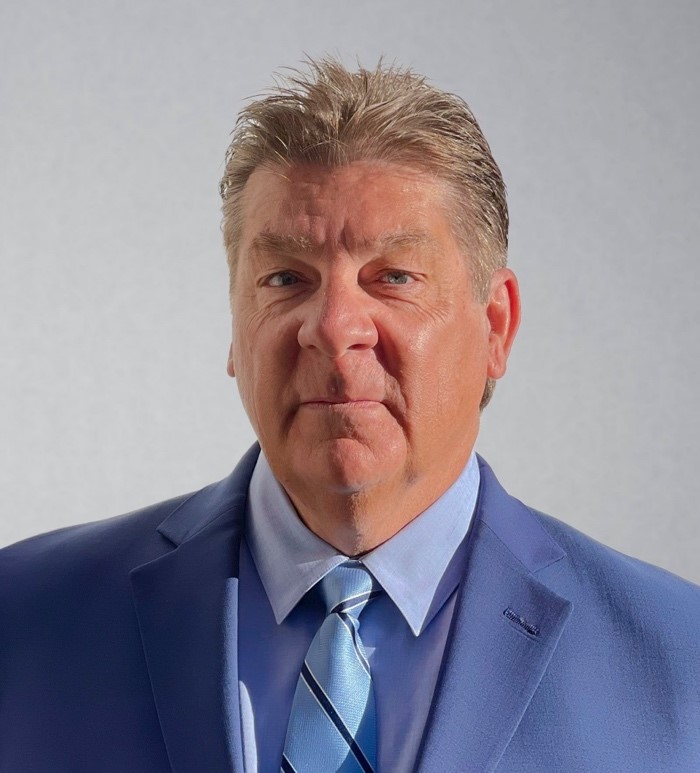 | |
Russ Kaurloto - So where do I begin?
I am a product of President Carter’s CETA program (Compensation Employment and Training Act) where I was accepted into the Lincoln Technical Institute, Pennsauken, NJ, just weeks after graduating from high school, where I was not only offered free tuition and books but paid minimum wage for each hour I was in class. I owe a lot to President Carter - had it not been for the CETA program, the following career path would have never occurred, at least not in this way.
Upon graduating from Lincoln Tech, a one-year (year-round) program, I interviewed and was hired by Personnel Director Jack Pace to join The Associated Press. I found out later that the Lincoln Technical Institute was a feeder for Jack to recruit technical staff into the East Brunswick NJ technical center, which was later relocated to Cranbury NJ.
Just a little background on how the technical staff was indoctrinated into the AP. Upon hiring, you went through a three-month training program at the East Brunswick tech center - a veritable boot camp for tech training. This was mandatory for all new technicians. Roy Bolch, who I know is a Connecting member, will vouch for the training program. Roy would size you up and down as a newbie - you had to go to his enormous, caged-in area for parts. Roy ran the parts department so he was like the sergeant at arms - you couldn’t build or work on any of the AP teletype equipment or obtain parts without going through Roy. After your 3-month boot camp, you became part of the UTW (United Telegraph Workers) union which later became the CWA (Communications Worker of America) union. How you obtained your union seniority and how you chose where you would be deployed, (which bureau you be assigned), was literally through the drawing of straws. By example, there were five new recruits in my group, I drew the second longest straw which gave me seniority above the three below and the 2nd choice to an open technician position across the country. Fortunately, there were two openings in the Philadelphia bureau which was 30 minutes from my parents’ home in South Jersey. Just to give you a sense of timing, I graduated from high school in 1977 and was hired by the AP in October 1978.
After tech boot camp, I started working at the Philadelphia bureau under Ray Goergen, who I wrote about in a prior Connecting. Talk about a tough boss. As I wrote prior, if you could survive Ray, you were more than prepared to survive in the NY corporate office - a terrifying proposition. After approximately a year or so working at the PHL bureau, I put in for a transfer to the LAX (Los Angeles) Bureau and to my surprise, an opening came up 30 days later - so I packed my bags and went west.
| 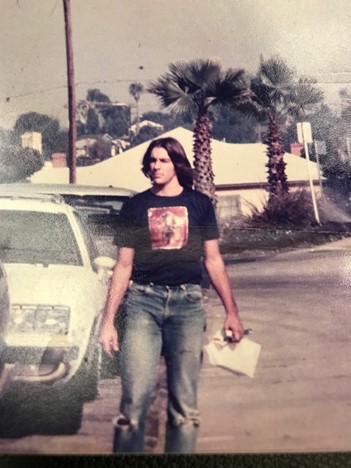 | |
(AP technician living the dream in Manhattan Beach Ca. circa 1980)
During that time, I moved up quickly through the ranks, breaking the AP rule of promoting from within - back then, you had to relocate to another bureau to advance in your career, not from within. I broke that mold. I was a technician for little over five years when an opening occurred with the departure of Bill Caddell as Assistant Chief of Communications.
|  | |
LA Bureau circa 1980’s
I realized early in my career that I wanted to be in management rather than the deep technical engineering - I’d like to think that throughout my career I’ve been pretty good at managing people. Just a few years later, an opening occurred with the stepping down of the COC (Chief of Communications) held by Russ Thomas. How that occurred is for another Connecting article. During that time, the LA Bureau was known nationally, specifically on the technical side, as a quagmire, the worst in the country; no one wanted to work in the LA bureau. Rumor was not only was it a bad working environment, the location at The Herald Examiner, was not desirable as well.
| |
|
From left to right – me, ACOB Peggy Walsh, and ACOC Dave Sloan circa 1980’s.
I raise the point since only myself and my friend, Dave Sloan, the other ACOC (Assistant Chief of Communications) applied for the position. I got the job and was one of the youngest COC’s in AP history. The youngest at that time was held by Gary Theis; he beat me by six months. I had just turned 30. One of the first assignments for me as COC was to help relocate the LA Bureau from The Herald Examiner building to where it is located today at 221 S. Figueroa St. LA. At the time, it was one of the largest bureau moves in AP history - outside of New York and Washington.
Below is a picture Nick Ut shot during the move - it was presented to me by Nick and my staff after we moved into the new bureau.
| 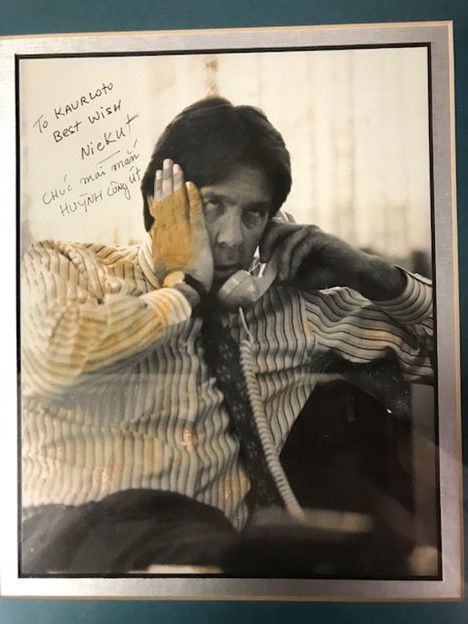 | |
I held the COC position until roughly 1997. During that year, I worked with Executive Director Phil Emanuel, NY, on restructuring the AP Communications bureaus across the country into four regions: East, West, Midwest and South. Prior, 39 COC’s reported directly to Phil, so creating the regions and promoting individuals to regional Executive Directors under Phil made sense - something the editorial side in the future emulated as well. Since I helped design the structure, I was promoted into the regional Executive Director (West) position which I held until my departure ending a 22-year career with the beloved AP.
I departed the AP LA bureau in 2000 for an executive position at The University of Southern California – it was the summer just prior to the upcoming Democratic National Convention which really chaffed the AP teams that came out to build the AP-DNC infrastructure and cover the convention. Especially since they were staying at the USC Radisson Hotel, so every morning when they stepped out the door, the entrance sign to USC’s campus was staring in their faces with the reminder of where I went.
I spent 15 years at USC holding several titles, from Deputy CIO, COO and Executive Director with responsibility over all IT including the USC Health Sciences Campus and the clinical space. I left USC for an opportunity as the Assistant General Manager of IT at the City of Los Angeles with responsibility for all IT infrastructure for the city across 800 plus buildings - LAPD / LAFD 911 was under my responsibility along aviation communications (helicopters and airplanes) - a whole new meaning to guys with guns. I would call my wife on the way home and say, yabba dabba, do, I just left the quarry - making an IT impact at the city was akin to chipping away at rocks in the Fred Flintstone quarry. I then departed the City of LA for an opportunity as the Chief Technology Officer at Children’s Hospital Los Angeles. I was offered the role due to my USC Health Sciences experience - the USC doctors are the physicians at CHLA. The role at CHLA gave me a completely new medical and IT support perspective - it’s one thing for adults to be sick, it’s completely another when it comes to children. Their motto is - it‘s all about the children - nothing else. While working at CHLA, a recruiter reached out and asked if I’d be interested in the Vice President & Chief Information Officer position at Clemson University.
I’ll digress for a moment - what most did not know, only Andy Lippman, was that I did not hold a college degree. Just consider, I obtained all of these positions, especially in higher education, without a formal degree - so my perspective on degree value is quite different than most. However, the glass ceiling does exist, and in my case, it was a cement ceiling not having a degree.
Through the continual pressure and nagging from Andy to get my degree, while at the AP, and throughout my career, was endless. Andy would say, “I’m getting adults from foreign countries to achieve their high school diplomas - you Russell have no excuse”. So, in 2015, I walked across the platform at California Lutheran University with a BS, Organizational Leadership. Had it not been for the support from Andy and my family, I would have never been offered the Vice President & CIO position at Clemson, frankly, due to prerequisites, I would not have been able to apply at all.
| |
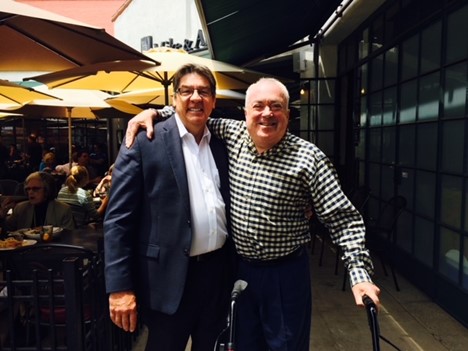 | |
Meeting with my mentor and dear friend Andy Lippman after I graduated.
I was offered and accepted the Clemson VP & CIO position - this at the beginning of its football rise and tremendous student growth. While at Clemson, I had responsibility for all IT but this time it included the IT support for SCDHHS (South Carolina Department Health & Human Services) - roughly $7 billion in claims per year. Fun stuff. It was toward the end of Covid, another recruiter reached out and asked if I would consider the Vice Chancellor & CIO role at The University of Denver. The opportunity of going back to a private university and with a Vice Chancellor role was too alluring and besides - it was Denver. So, this is where I currently am but reside between Los Angeles, Denver and Keowee Key, South Carolina. In IT you can work from anywhere.
So that’s what I’ve been up to since I left our beloved AP. But it needs to be said, had it not been for the phenomenal relationships, friendships and support I was so fortunate to develop through my years at The AP, I would not have been able to achieve the successful journey that has brought me to where I am today.
The journey continues.
| |
|
Stories of interest
Past Fox firings carry lessons for network after Carlson (AP)
By DAVID BAUDER
NEW YORK (AP) — Before ousting Tucker Carlson, Fox News had twice fired wildly popular hosts – and both times the network recovered better than the stars it cut loose.
Fox’s dismissals of Glenn Beck in 2011 and Bill O’Reilly in 2017 offer lessons in what the post-Carlson fallout might be. Carlson was let go on Monday, less than a week after Fox agreed to pay Dominion Voting Systems $787 million for airing bogus claims of voter fraud following the 2020 election.
Fox’s two most popular programs last year — Carlson’s being one of them — were the replacements for Beck and O’Reilly.
“It seems like the parts are interchangeable,” said SiriusXM and CNN personality Michael Smerconish. “They’ve built a machine over there that seems to function even when the pistons are replaced.”
Still, Carlson’s ability to connect with supporters of former President Donald Trump could benefit him wherever he lands.
Read more here.
-0-
Tucker Carlson was Fox News’s biggest star. Then he became its biggest liability (Guardian)
Margaret Sullivan
On any other day, the revelation that anchor Don Lemon was out at CNN would have been a big deal in the world of media news.
But Tucker Carlson’s abrupt toppling from his primetime perch at Fox News not only overshadowed that development by a mile, but it threw the whole rightwing media ecosystem into a tailspin.
Carlson has been far more than a cable-news host over the half-dozen years since he took that prominent evening slot and became Fox’s most-watched personality.
He has been America’s chief fomenter of populist resentments, its go-to guy for the politics of grievance and – despite his smarmy demeanor, and aging prep-school appearance – he’s been a twisted kind of working-class hero.
“Carlson has been uniquely dangerous and damaging – the leading figure in the right’s larger undertaking of making stuff up and inciting a hate-filled narrative against the educated, cosmopolitan elite,” said Linda Hirshman, an author and cultural historian who studies and writes about social movements.
Read more here.
-0-
Nearly 25% of Arizona Daily Star newsroom laid off (Tucson Sentinel)
Dylan Smith & Paul Ingram
From the top editor on down, the Arizona Daily Star staff was cut by nearly one-quarter on Monday, as the Tucson newspaper's corporate chain owners told local journalists they were being laid off.
The cuts were "deep, wide and high," one remaining staffer said.
Of the approximately 35-40 employees in the newsroom after previous rounds of layoffs and buyouts, 10 were laid off, sources told the Tucson Sentinel. About that many business-side staffers were let go last week.
Among those laid off Monday was Jill Jorden Spitz, editor of the newspaper for almost seven years, who joined the Star staff more than two decades ago.
Also cut were Curt Prendergast, the opinion page editor, and photo editor Rick Wiley, who's helmed that desk since 2004. Sources also said the Star was ending its Spanish-language publication, La Estrella. Several other journalists — from relatively new hires to veterans of more than 30 years — were also cut from the Star's staff, sources said.
Read more here. Shared by Mark Mittelstadt.
| |
Today in History - April 26, 2023 | |
|
Today is Wednesday, April 26, the 116th day of 2023. There are 249 days left in the year.
Today’s Highlight in History:
On April 26, 1986, an explosion and fire at the Chernobyl nuclear power plant in Ukraine caused radioactive fallout to begin spewing into the atmosphere. (Dozens of people were killed in the immediate aftermath of the disaster while the long-term death toll from radiation poisoning is believed to number in the thousands.)
On this date:
In 1607, English colonists went ashore at present-day Cape Henry, Virginia, on an expedition to establish the first permanent English settlement in the Western Hemisphere.
In 1865, John Wilkes Booth, the assassin of President Abraham Lincoln, was surrounded by federal troops near Port Royal, Virginia, and killed.
In 1913, Mary Phagan, a 13-year-old worker at a Georgia pencil factory, was strangled; Leo Frank, the factory superintendent, was convicted of her murder and sentenced to death. (Frank’s death sentence was commuted, but he was lynched by an anti-Semitic mob in 1915.)
In 1933, Nazi Germany’s infamous secret police, the Gestapo, was created.
In 1964, the African nations of Tanganyika and Zanzibar merged to form Tanzania.
In 1968, the United States exploded beneath the Nevada desert a 1.3 megaton nuclear device called “Boxcar.”
In 1977, the legendary nightclub Studio 54 had its opening night in New York.
In 1984, bandleader Count Basie, 79, died in Hollywood, Florida.
In 1994, voting began in South Africa’s first all-race elections, resulting in victory for the African National Congress and the inauguration of Nelson Mandela as president.
In 2000, Vermont Gov. Howard Dean signed the nation’s first bill allowing same-sex couples to form civil unions.
In 2009, the United States declared a public health emergency as more possible cases of swine flu surfaced from Canada to New Zealand; officials in Mexico City closed everything from concerts to sports matches to churches in an effort to stem the spread of the virus.
In 2018, comedian Bill Cosby was convicted of drugging and molesting Temple University employee Andrea Constand at his suburban Philadelphia mansion in 2004. (Cosby was later sentenced to three to 10 years in prison, but Pennsylvania’s highest court threw out the conviction and released him from prison in June 2021, ruling that the prosecutor in the case was bound by his predecessor’s agreement not to charge Cosby.)
Ten years ago: Unable to ignore air travelers’ anger, Congress overwhelmingly approved legislation to allow the Federal Aviation Administration to withdraw furloughs of air traffic controllers caused by budget-wide cuts known as the sequester, ending a week of coast-to-coast flight delays. Fire at a psychiatric hospital near Moscow killed 38 people; only three escaped. Country singer George Jones, 81, died in Nashville.
Five years ago: Mike Pompeo was sworn in as secretary of state, minutes after being confirmed by the Senate; he then flew immediately to Brussels for meetings at NATO headquarters. President Donald Trump’s White House doctor, Ronny Jackson, withdrew his nomination to be Veterans Affairs secretary in the face of accusations of misconduct. Teachers in Arizona and Colorado converged on state capitols as they launched widespread walkouts in a bid for better pay and education funding. Four quarterbacks were chosen in the first 10 selections in the NFL draft, with the Cleveland Browns grabbing Heisman Trophy winner Baker Mayfield out of Oklahoma.
One year ago: Russia pounded eastern and southern Ukraine as the U.S. promised to “keep moving heaven and earth” to get Kyiv the weapons it needed to repel the new offensive, despite Moscow’s warnings that such support could trigger a wider war. Vice President Kamala Harris tested positive for COVID-19 but exhibited no symptoms. Harvard University vowed to spend $100 million to research and atone for its “extensive” ties with slavery.
Today’s Birthdays: Actor-comedian Carol Burnett is 90. R&B singer Maurice Williams is 85. Songwriter-musician Duane Eddy is 85. Rock musician Gary Wright is 80. Actor Nancy Lenehan is 70. Actor Giancarlo Esposito is 65. Rock musician Roger Taylor (Duran Duran) is 63. Actor Joan Chen is 62. Rock musician Chris Mars (The Replacements) is 62. Actor-singer Michael Damian is 61. Actor Jet Li (lee) is 60. Actor-comedian Kevin James is 58. Author and former U.S. Poet Laureate Natasha Trethewey (TREHTH’-eh-way) is 57. Actor Marianne Jean-Baptiste is 56. Rapper T-Boz (TLC) is 53. Former first lady Melania Trump is 53. Actor Shondrella Avery is 52. Actor Simbi Kali is 52. Country musician Jay DeMarcus (Rascal Flatts) is 52. Rock musician Jose Pasillas (Incubus) is 47. Actor Jason Earles is 46. Actor Leonard Earl Howze is 46. Actor Amin Joseph is 46. Actor Tom Welling is 46. Actor Pablo Schreiber is 45. Actor Nyambi Nyambi is 44.
| |
Got a story or photos to share? | |
|
Connecting is a daily newsletter published Monday through Friday that reaches more than 1,800 retired and former Associated Press employees, present-day employees, and news industry and journalism school colleagues. It began in 2013. Past issues can be found by clicking Connecting Archive in the masthead. Its author, Paul Stevens, retired from the AP in 2009 after a 36-year career as a newsman in Albany and St. Louis, correspondent in Wichita, chief of bureau in Albuquerque, Indianapolis and Kansas City, and Midwest vice president based in Kansas City.
Got a story to share? A favorite memory of your AP days? Don't keep them to yourself. Share with your colleagues by sending to Ye Olde Connecting Editor. And don't forget to include photos!
Here are some suggestions:
- Connecting "selfies" - a word and photo self-profile of you and your career, and what you are doing today. Both for new members and those who have been with us a while.
- Second chapters - You finished a great career. Now tell us about your second (and third and fourth?) chapters of life.
- Spousal support - How your spouse helped in supporting your work during your AP career.
- My most unusual story - tell us about an unusual, off the wall story that you covered.
- "A silly mistake that you make"- a chance to 'fess up with a memorable mistake in your journalistic career.
- Multigenerational AP families - profiles of families whose service spanned two or more generations.
- Volunteering - benefit your colleagues by sharing volunteer stories - with ideas on such work they can do themselves.
- First job - How did you get your first job in journalism?
- Most unusual place a story assignment took you.
Paul Stevens
Editor, Connecting newsletter
paulstevens46@gmail.com
| | | | |